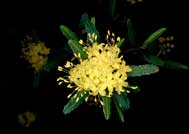In Flower This Week
A weekly news sheet prepared by a Gardens' volunteer.
Numbers before each plant refer to temporary IFTW labels in the gardens.
Numbers in square brackets [ ] refer to garden bed Sections. Plants in flower are in bold type.
View past issues of 'In Flower This Week'.
9 July 2014
Phebalium squamulosum
click for larger image |
Today we will walk along the Main Path between the café and the beginning of the Sydney Region Gully. There are plenty of plants in flower, even in the middle of winter.
- Banksia ‘Stumpy Gold’ [Section 131] on your left is a neat low bush with many golden flowers. This plant is a dwarf cultivar of Banksia spinulosa var. collina that was selected by Richard Anderson of Merricks Nursery in Victoria.
- Eucalyptus gregsoniana [Section 131], also known as the Wolgan Snow Gum, is a mallee that is found in the highlands of New South Wales. The tree, on your left, has fluffy white flowers and attractive bark.
- Epacris longiflora [Section 131], or Native Fuchsia, on your left, has thin tubular white-tipped red flowers on a small prickly bush. This species belongs to the heath family and its native range extends from the central coast of New South Wales to southern Queensland.
- Epacris longiflora ‘Nectar Pink’ [Section 131], also on your left, is a selection from the above species. It is a very floriferous small shrub covered in slender pink bell flowers with white tips.
- Acacia alata var. biglandulosa [Section 240], or Winged Wattle, on the right, has flattened phyllodes and masses of white fluffy ball flowers. It is native to Western Australia.
- Turn up the hill now along the Main Path. A Thryptomene sp. [Section 10] on your left is an airy bush with a graceful, arching habit and close neat foliage. It is covered in clusters of tiny pink flowers with darker centres.
- Grevillea speciosa [Section 30] on the left, also known as Red Spider Flower, is a shrub which is endemic to New South Wales. It has bright red terminal clusters of flowers on a neat bush.
- Banksia ericifolia subsp. ericifolia [Section 30], on your left, is a long-flowering, medium-sized shrub with attractive divided foliage and long orange inflorescences. It is native to New South Wales, but has naturalised in small numbers in Victoria.
- Grevillea diminuta [Section 30] on your left has hanging clusters of orange/red flowers on a neat medium-sized bush. It is native to New South Wales and the ACT. It was first formally described by Lawrie Johnson in 1962.
- Banksia spinulosa var. neoanglica [Section 7], or New England Banksia, on your left, has silver-backed dark green foliage with glorious yellow/gold brushes held upright. It is a shrub that grows along the east coast of Queensland and New South Wales.
- Banksia marginata ‘Cape Patterson Dwarf’ [Section 26], across the road on the right, is an unusual small version of our common local Banksia marginata. It has bright yellow brushes and silver-backed foliage.
- Also on your right is Grevillea centristigma [Section 26], a small bush with soft lush foliage fringed with white hairs. Pendent hard yellow/orange flowers open from greenish buds. It is endemic to the south-west region of Western Australia.
- Grevillea manglesii subsp. ornithopoda [Section 24], or Birdsfoot Grevillea, on the left, is a large open bush with pincushion-like white flower heads all along the stems. It is native to Western Australia.
- Continuing on your right is Grevillea vestita subsp. isopogoides [Section 26], a spreading, prostrate, prickly bush with masses of white starburst flowers native to Western Australia.
- Phebalium squamulosum [Section 112], on your left, is a small bush with yellow star flowers with prominent stamens. It is endemic to eastern Australia.
Rosalind Walcott
![Director of National Parks [logo]](../../../../images/dnp_90px.gif)







